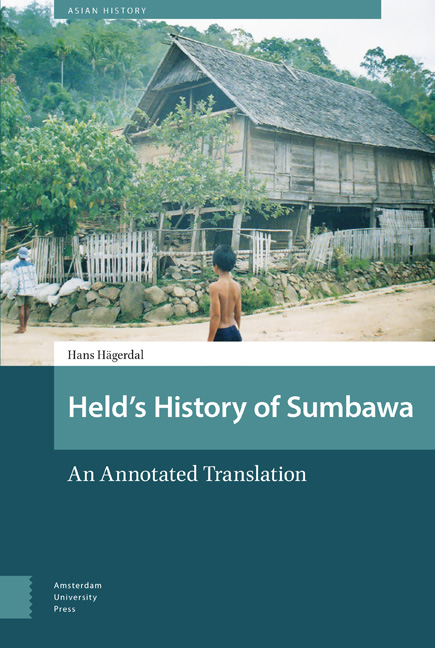Book contents
- Frontmatter
- Contents
- List of Figures and Tables
- Map
- Translator’s Introduction
- 1 The Ancient Period
- 2 Islam and Makassar
- 3 The Sumbawan Kingdoms under VOC Suzerainty (1)
- 4 The Sumbawan Kingdoms under VOC Suzerainty (2)
- 5 In the Wake of the Tambora Disaster
- 6 From Colonial rule to Independence
- Appendix: Lists of Sumbawan Rulers
- Bibliograph
- Index
5 - In the Wake of the Tambora Disaster
Published online by Cambridge University Press: 10 December 2020
- Frontmatter
- Contents
- List of Figures and Tables
- Map
- Translator’s Introduction
- 1 The Ancient Period
- 2 Islam and Makassar
- 3 The Sumbawan Kingdoms under VOC Suzerainty (1)
- 4 The Sumbawan Kingdoms under VOC Suzerainty (2)
- 5 In the Wake of the Tambora Disaster
- 6 From Colonial rule to Independence
- Appendix: Lists of Sumbawan Rulers
- Bibliograph
- Index
Summary
[Tambora]
In the Encyclopaedie [van Nederlandsch Oost-indie] one may read under the word Tambora: ‘The main crater is almost round and 6 to 6 1/2 kilometres in diameter; the loftiest point of the crater edge (the west side) is plus or minus 2,800 metres; the bottom of the crater, which has steep walls, is situated 500 to 600 metres deeper, and has got a small lake at the eastern side … Tambora is well-known due to the violent eruption from 5 April to 15 June 1815, whereby 12,000 people succumbed directly and an estimated 44,000 people died of hunger as a result … The elliptic area where the ashes fell down was (taking Tambora as the point of departure) about 555 kilometres from north to south, 400 kilometres to the east (to the middle of Flores), 1,100 kilometres to the west (to Cirebon) … It is asserted that the mountain became about one-third lower by the eruption, and it was probably then that the present caldera was formed. Van Rheden estimates the part of the summit that vanished to 30 cubic kilometres’ (Encyclopaedie , IV, p. 254).
[End of Tambora and Pekat, 1866]
Kuperus, who has made a detailed study of the cultural-geographical situation of Pulau Sumbawa, mentions the year 1815 as the starting point of a new period of development, and we follow him in his view. The empty land of Tambora was, after discussions begun in 1861, annexed to Sanggar in 1866 and continued to exist as a separate petty kingdom until 1928.
[End of Sanggar, 1928]
It was then annexed to the Kingdom of Bima. In 1928 it had a population of 1,800 people, who lived in five small villages. Pekat was annexed to Dompu in 1866. In 1862 the Taloko region was also annexed to Dompu, even though it had been occupied by the Sanggarese for a few years. It was deemed that this area had belonged to Dompu and to Bima in turns, but never to Sanggar. This is supposedly the Corre Talouga of 1748.
- Type
- Chapter
- Information
- Held's History of SumbawaAn Annotated Translation, pp. 141 - 170Publisher: Amsterdam University PressPrint publication year: 2017



